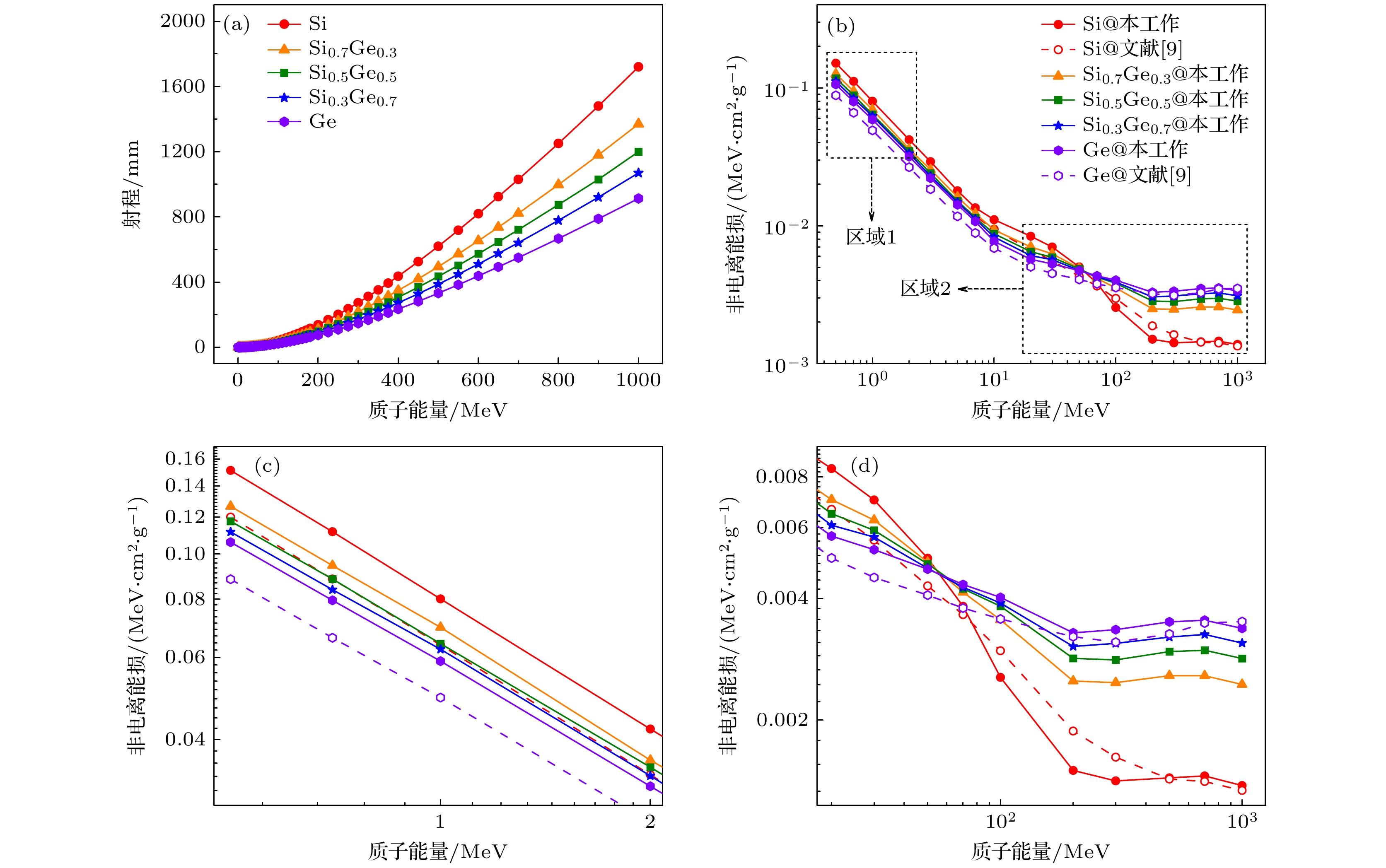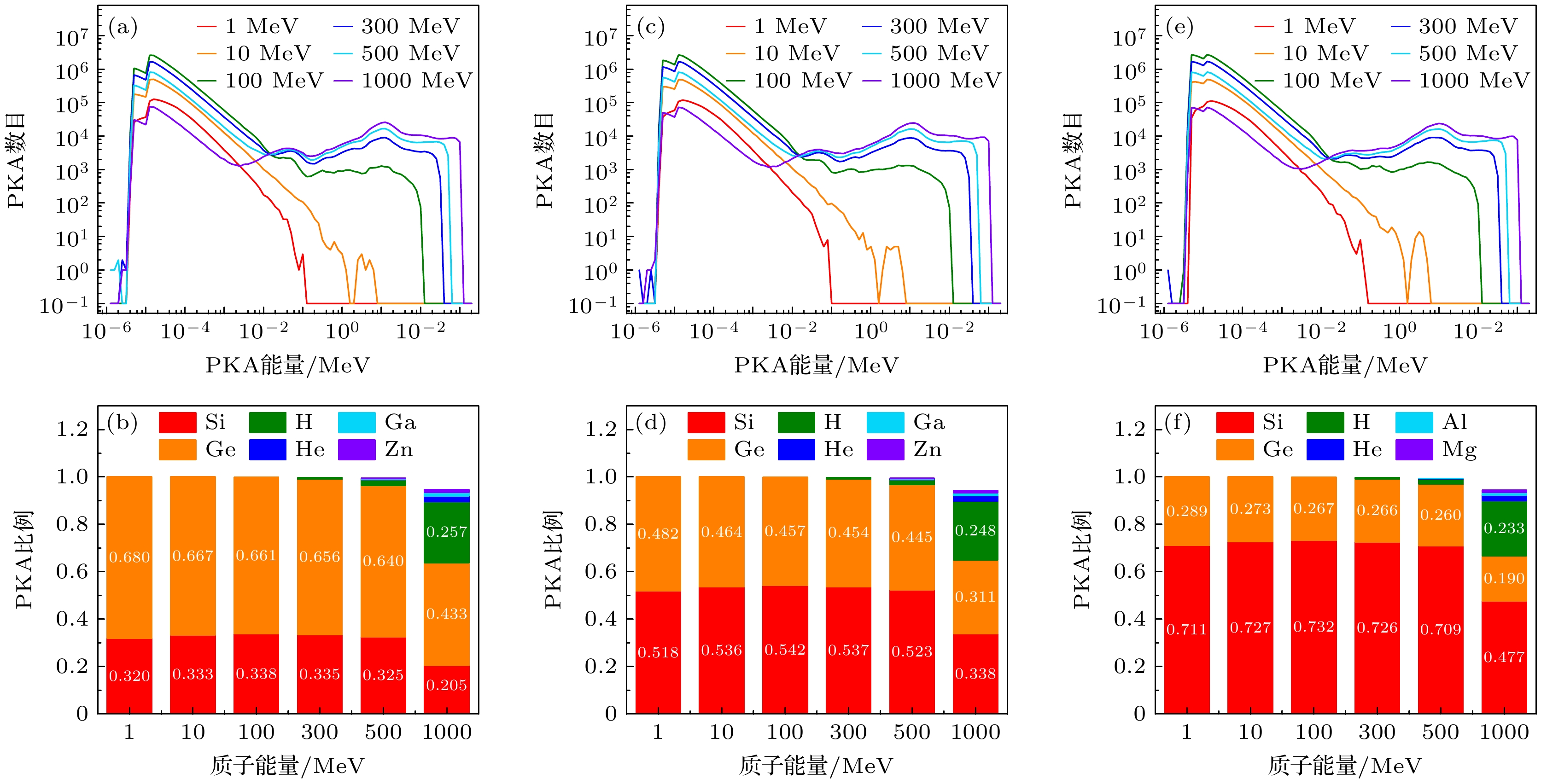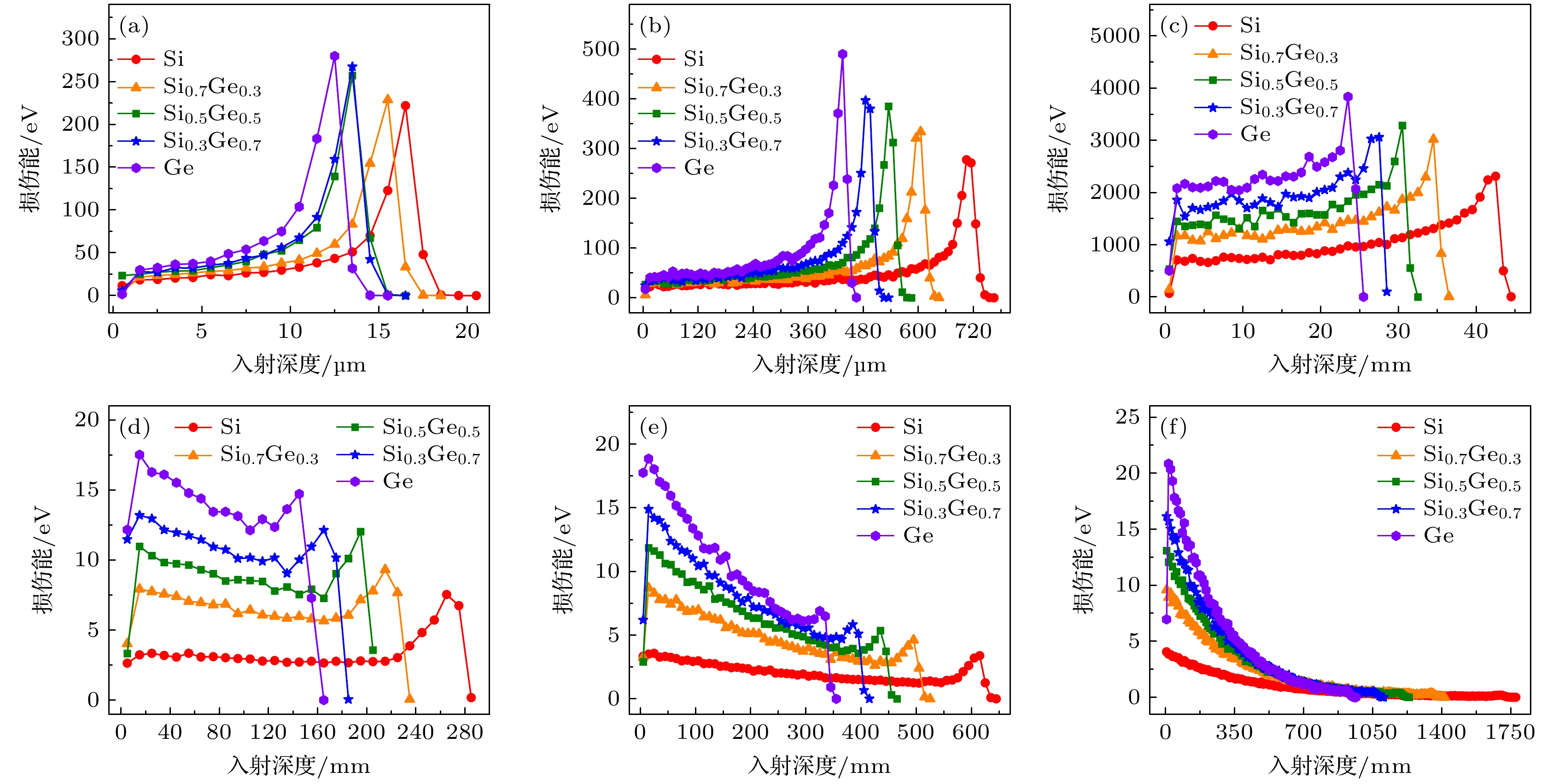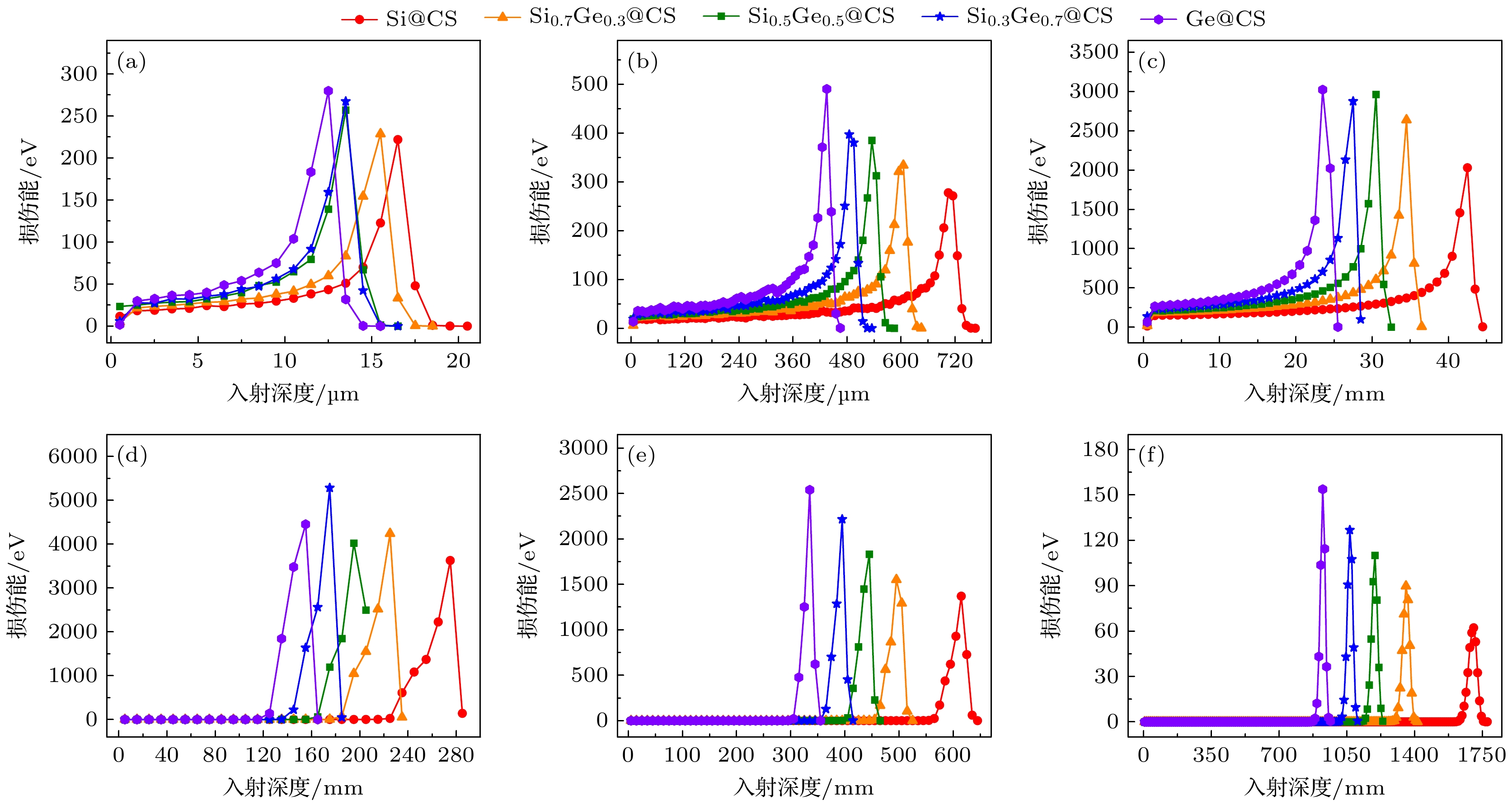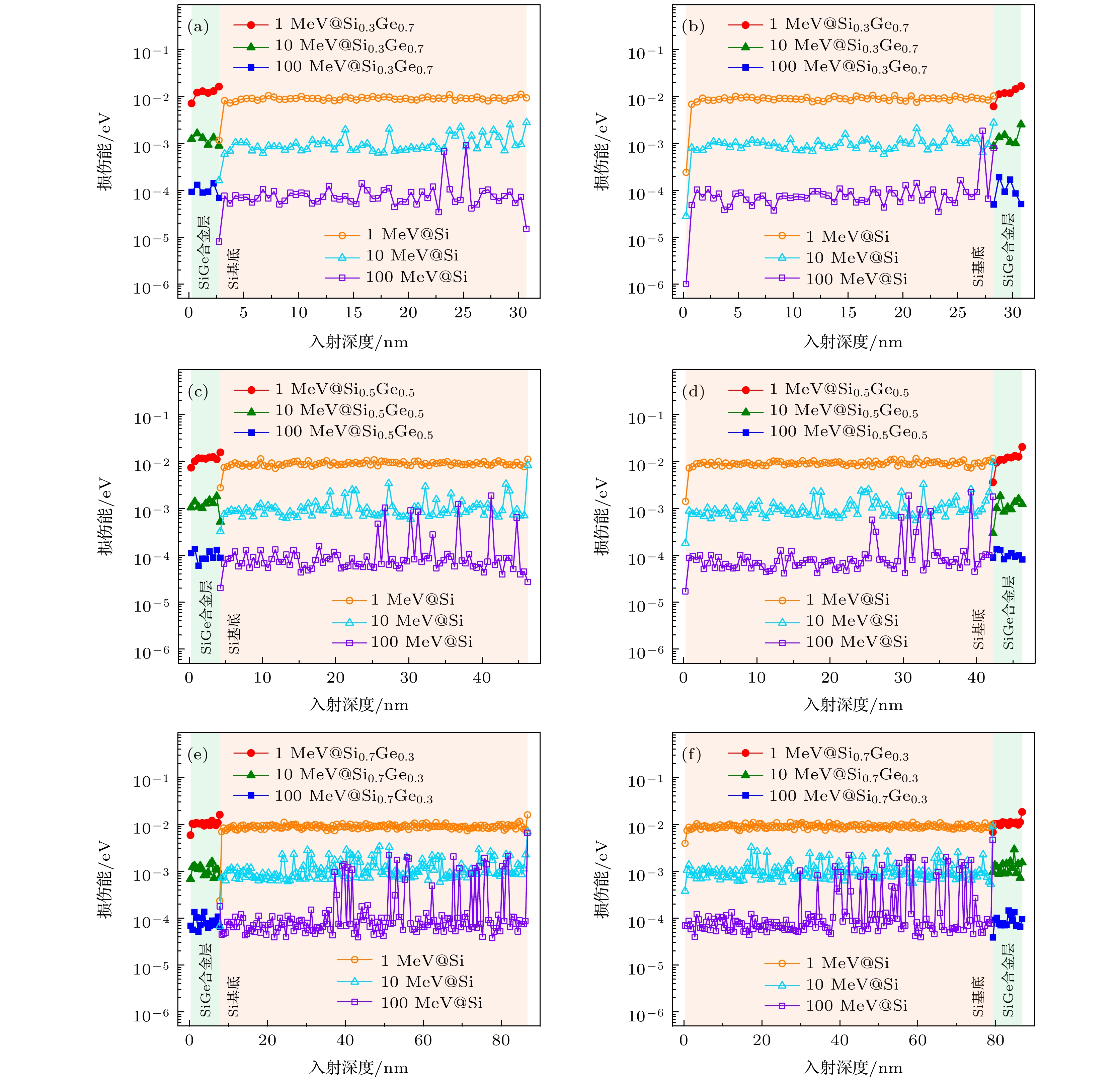-
基于SiGe合金的电子器件具有广阔的空间应用前景, 但是也受到空间环境中粒子辐照损伤的威胁. 本文通过蒙特卡罗模拟研究了1—1000 MeV质子对SiGe合金和SiGe/Si异质结构造成的位移损伤. 结果表明, 低能质子(1—100 MeV)在SiGe合金中主要通过库仑散射和弹性碰撞产生Si初级离位原子(primary knock-on atom, PKA)和Ge PKA, 损伤能分布在质子射程末端形成一个明显的布拉格峰, 而高能质子(300—1000 MeV)在SiGe合金中的非弹性碰撞更加显著, 出现更多的PKA类型, 损伤能主要分布在质子射程前端. 同时, 质子在SiGe/Si异质结构中的损伤能随质子能量的增大呈现出整体下降的趋势, 反向入射质子(10 MeV和100 MeV)比正向入射质子在界面处Si基底一侧产生的损伤能更大, 导致界面两侧的损伤能起伏更为剧烈, 可能造成更加严重的位移损伤. 此外, Ge含量会影响质子在SiGe合金中的PKA类型、损伤能分布和非电离能量损失, 随着Ge含量的增大, 高能质子在SiGe合金中的非电离能量损失逐渐变大, 但是, Ge含量对质子在小尺寸SiGe/Si异质结构中总损伤能的影响不显著. 总体上, 这项工作说明了质子在SiGe合金和SiGe/Si异质结构中产生的位移损伤和质子能量密切相关, 低能质子倾向于产生更多的自反冲原子, 并在小尺寸SiGe/Si异质结构中产生位移损伤, 为SiGe合金基电子器件的位移损伤效应研究和抗辐照加固技术提供了数据支持.SiGe-based electronics have a promising prospect in the field of space exploration due to the controllable bandgap of SiGe alloys and high compatibility with Si technology. However, they may be susceptible to the influence of energetic particles in space radiation environments. In order to explain the potential displacement damage in SiGe-based electronics, Monte Carlo simulations are conducted to investigate the displacement damage in SiGe alloys and SiGe/Si heterostructures induced by 1–1000 MeV protons. The displacement damage in SiGe alloys is studied by the energy spectra and types of proton-induced primary knock-on atoms (PKAs) and the related damage energy distribution, while the displacement damage in SiGe/Si heterostructures is studied by the damage energy distribution caused by forward- and reverse-incident protons. Low-energy protons (1–100 MeV) primarily generate Si PKAs and Ge PKAs in SiGe alloys through Coulomb scattering and elastic collisions, and the corresponding damage energy distribution exhibits a distinct Bragg peak at the end of the proton range. Meanwhile, high-energy protons (300–1000 MeV) cause significant inelastic collisions in SiGe alloys, leading to a series of other PKA types, with the associated damage energy distribution predominantly located in the front of the proton range. In addition, the damage energy in SiGe/Si heterostructures generally decreases as the proton energy increases, and compared with the forward-incident protons, the reverse-incident protons (10 MeV and 100 MeV) cause greater damage energy on the side of Si substrate at the interface, and result in more noticeable fluctuations in damage energy on both sides of the interface, probably leading to severe displacement damage. Besides, Ge content can affect the PKA type, damage energy distribution, and nonionizing energy loss. As for high-energy protons, high Ge content may lead to a great nonionizing energy loss in SiGe alloys, whereas the Ge content has an insignificant effect on the total damage energy of small-size SiGe/Si heterostructures. In summary, this work indicates that the proton-induced displacement damage in SiGe alloys and SiGe/Si heterostructures is greatly dependent on the proton energy, and low-energy protons are prone to generating massive self-recoil atoms, inducing significant displacement damage in small-size SiGe/Si heterostructures, which will provide theoretical basis and reference for studying displacement damage effect and developing radiation hardening techniques of SiGe-based electronics.
-
Keywords:
- SiGe /
- heterostructure /
- proton /
- displacement damage /
- Monte Carlo simulation
[1] Li L, Bi R, Dong Z Y, Ye C Q, Xie J, Wang C L, Li X M, Pey K L, Li M, Wu X 2024 Electron 2 e32
 Google Scholar
Google Scholar
[2] Böck J, Aufinger K, Boguth S, et al. 2015 IEEE Bipolar/BiCMOS Circuits and Technology Meeting—BCTM Octorber 26–28, 2015 pp121–124
[3] 李培, 董志勇, 郭红霞, 张凤祁, 郭亚鑫, 彭治钢, 贺朝会 2024 物理学报 73 044301
 Google Scholar
Google Scholar
Li P, Dong Z Y, Guo H X, Zhang F Q, Guo Y X, Peng Z G, He C H 2024 Acta Phys. Sin. 73 044301
 Google Scholar
Google Scholar
[4] 马羽, 张培健, 徐学良, 陈仙, 易孝辉 2023 微电子学 53 272
Ma Y, Zhang P J, Xu X L, Chen X, Yi X H 2023 Microelectron. 53 272
[5] Chancellor J, Nowadly C, Williams J, et al. 2021 J. Environ. Sci. Health Part C 39 113
 Google Scholar
Google Scholar
[6] Cressler J D 2013 IEEE Trans. Nucl. Sci. 60 1992
 Google Scholar
Google Scholar
[7] 何欢, 白雨蓉, 田赏, 刘方, 臧航, 柳文波, 李培, 贺朝会 2024 物理学报 73 052402
 Google Scholar
Google Scholar
He H, Bai Y R, Tian S, Liu F, Zang H, Liu W B, Li P, He C H 2024 Acta Phys. Sin. 73 052402
 Google Scholar
Google Scholar
[8] 白雨蓉, 李永宏, 刘方, 廖文龙, 何欢, 杨卫涛, 贺朝会 2021 物理学报 70 172401
 Google Scholar
Google Scholar
Bai Y R, Li Y H, Liu F, Liao W L, He H, Yang W T, He C H 2021 Acta Phys. Sin. 70 172401
 Google Scholar
Google Scholar
[9] Insoo J, Xapsos M A, Messenger S R, Burke E A, Walters R J, Summers G P, Jordan T 2003 IEEE Trans. Nucl. Sci. 50 1924
 Google Scholar
Google Scholar
[10] 朱金辉, 韦源, 谢红刚, 牛胜利, 黄流兴 2014 物理学报 63 066102
 Google Scholar
Google Scholar
Zhu J H, Wei Y, Xie H G, Niu S L, Huang L X 2014 Acta Phys. Sin. 63 066102
 Google Scholar
Google Scholar
[11] Sun Y B, Fu J, Xu J, Wang Y D, Zhou W, Zhang W, Cui J, Li G Q, Liu Z H 2013 Nucl. Instrum. Methods Phys. Res., Sect. B 312 77
 Google Scholar
Google Scholar
[12] 李永宏, 寇勃晨, 赵耀林, 贺朝会, 于庆奎 2018 原子能科学技术 52 1735
 Google Scholar
Google Scholar
Li Y H, Kou B C, Zhao Y L, He C H, Yu Q K 2018 At. Energ. Sci. Technol. 52 1735
 Google Scholar
Google Scholar
[13] Fan J Q, Tan Q, Hao J H 2022 AIP Adv. 12 095304
 Google Scholar
Google Scholar
[14] 白雨蓉, 李培, 何欢, 刘方, 李薇, 贺朝会 2024 物理学报 73 052401
 Google Scholar
Google Scholar
Bai Y R, Li P, He H, Liu F, Li W, He C H 2024 Acta Phys. Sin. 73 052401
 Google Scholar
Google Scholar
[15] 申帅帅, 贺朝会, 李永宏 2018 物理学报 67 182401
 Google Scholar
Google Scholar
Shen S S, He C H, Li Y H 2018 Acta Phys. Sin. 67 182401
 Google Scholar
Google Scholar
[16] 李培, 贺朝会, 郭红霞, 张晋新, 魏佳男, 刘默寒 2022 太赫兹科学与电子信息学报 20 523
 Google Scholar
Google Scholar
Li P, He C H, Guo H X, Zhang J X, Wei J N, Liu M H 2022 J. Terahertz Sci. Electron. Inf. Technol. 20 523
 Google Scholar
Google Scholar
[17] 张晋新, 郭红霞, 吕玲, 王信, 潘霄宇 2022 太赫兹科学与电子信息学报 20 869
 Google Scholar
Google Scholar
Zhang J X, Guo H X, Lü L, Wang X, Pan X Y 2022 J. Terahertz Sci. Electron. Inf. Technol. 20 869
 Google Scholar
Google Scholar
[18] Pan X Y, Guo H X, Feng Y H, et al. 2022 Sci. China: Technol. Sci. 65 1193
 Google Scholar
Google Scholar
[19] Sotskov D I, Elesin V V, Kuznetsov A G, et al. 2020 IEEE Trans. Nucl. Sci. 67 2396
 Google Scholar
Google Scholar
[20] Sotskov D I, Kuznetsov A G, Elesin V V, Selishchev I A, Kotov V N, Nikiforov A Y 2021 21th European Conference on Radiation and Its Effects on Components and Systems (RADECS) September 13–17 2021 pp1–4
[21] Li P, He C H, Guo H X, Li Y H, Wei J N 2022 IEEE Trans. Nucl. Sci. 69 1051
 Google Scholar
Google Scholar
[22] Haugerud B M, Pratapgarhwala M M, Comeau J P, et al. 2006 Solid-State Electron. 50 181
 Google Scholar
Google Scholar
[23] Diez S, Lozano M, Pellegrini G, et al. 2009 IEEE Trans. Nucl. Sci. 56 1931
 Google Scholar
Google Scholar
[24] Li Z Q, Liu S H, Adekoya M A, Ren X T, Zhang J, Liu S Y, Li L 2021 Microelectron. Reliab. 127 114396
 Google Scholar
Google Scholar
[25] Jarrin T, Jay A, Raine M, Mousseau N, Hémeryck A, Richard N 2020 IEEE Trans. Nucl. Sci. 67 1273
 Google Scholar
Google Scholar
[26] Xing T, Liu S H, Wang X, et al. 2023 Radiat. Eff. Defects Solids 178 1384
 Google Scholar
Google Scholar
[27] Allison J, Amako K, Apostolakis J, et al. 2016 Nucl. Instrum. Methods Phys. Res., Sect. A 835 186
 Google Scholar
Google Scholar
[28] Douglas J P 2004 Semicond. Sci. Technol. 19 R75
 Google Scholar
Google Scholar
[29] Raine M, Jay A, Richard N, Goiffon V, Girard S, Gaillardin M, Paillet P 2017 IEEE Trans. Nucl. Sci. 64 133
 Google Scholar
Google Scholar
[30] Tylka A J, Adams J H, Boberg P R, et al. 1997 IEEE Trans. Nucl. Sci. 44 2150
 Google Scholar
Google Scholar
[31] Mesick K E, Bartlett K D, Coupland D D S, Stonehill L C 2019 Nucl. Instrum. Methods Phys. Res. , Sect. A 948 162774
 Google Scholar
Google Scholar
[32] Ye E L, Lai Y F, Shen C X, Hou Y J, Nan H J 2025 Radiat. Phys. Chem. 228 112417
 Google Scholar
Google Scholar
[33] Robinson M T, Torrens I M 1974 Phys. Rev. B 9 5008
 Google Scholar
Google Scholar
[34] Akkerman A, Barak J 2006 IEEE Trans. Nucl. Sci. 53 3667
 Google Scholar
Google Scholar
[35] Song C, Liu S H, Wang X, Mu H B, Bai Y R, Li H D, Xing T, He C H, Chen W 2023 Nucl. Instrum. Methods Phys. Res., Sect. B 545 165144
 Google Scholar
Google Scholar
[36] Ziegler J F, Ziegler M D, Biersack J P 2010 Nucl. Instrum. Methods Phys. Res., Sect. B 268 1818
 Google Scholar
Google Scholar
-
图 3 质子在SiGe合金中产生的PKA能谱和前6种PKA比例 (a) Si0.3Ge0.7的PKA能谱; (b) Si0.3Ge0.7的PKA比例; (c) Si0.5Ge0.5的PKA能谱; (d) Si0.5Ge0.5的PKA比例; (e) Si0.7Ge0.3的PKA能谱; (f) Si0.7Ge0.3的PKA比例
Fig. 3. Energy spectra of proton-induced PKAs and the proportions of top six types of PKAs in SiGe alloys: (a) PKA enegy spectra of Si0.3Ge0.7; (b) PKA proportions of Si0.3Ge0.7; (c) PKA enegy spectra of Si0.5Ge0.5; (d) PKA proportions of Si0.5Ge0.5; (e) PKA enegy spectra of Si0.7Ge0.3; (f) PKA proportions of Si0.7Ge0.3.
图 4 质子在SiGe合金中产生的损伤能随入射深度的分布 (a) 1 MeV质子; (b) 10 MeV质子; (c) 100 MeV质子; (d) 300 MeV质子; (e) 500 MeV质子; (f) 1000 MeV质子
Fig. 4. Distribution of damage energy in SiGe alloys produced by protons along the penetration depth: (a) 1 MeV proton; (b) 10 MeV proton; (c) 100 MeV proton; (d) 300 MeV proton; (e) 500 MeV proton; (f) 1000 MeV proton.
图 5 质子在SiGe合金中通过库仑散射(CS)产生的损伤能随入射深度的分布 (a) 1 MeV质子; (b) 10 MeV质子; (c) 100 MeV质子; (d) 300 MeV质子; (e) 500 MeV质子; (f) 1000 MeV质子
Fig. 5. Distribution of damage energy in SiGe alloys produced by protons via the Coulomb scattering (CS) along the penetration depth: (a) 1 MeV proton; (b) 10 MeV proton; (c) 100 MeV proton; (d) 300 MeV proton; (e) 500 MeV proton; (f) 1000 MeV proton.
图 6 质子在SiGe/Si异质结构中产生的损伤能随入射深度的分布 (a)质子正向入射Si0.3Ge0.7/Si; (b)质子反向入射Si0.3Ge0.7/Si; (c)质子正向入射Si0.5Ge0.5/Si; (d)质子反向入射Si0.5Ge0.5/Si; (e)质子正向入射Si0.7Ge0.3/Si; (f)质子反向入射Si0.7Ge0.3/Si
Fig. 6. Distribution of damage energy in SiGe/Si heterostructures produced by protons along the penetration depth: (a) Proton incident forward on Si0.3Ge0.7/Si; (b) proton incident reversely on Si0.3Ge0.7/Si; (c) proton incident forward on Si0.5Ge0.5/Si; (d) proton incident reversely on Si0.5Ge0.5/Si; (e) proton incident forward on Si0.7Ge0.3/Si; (f) proton incident reversely on Si0.7Ge0.3/Si.
-
[1] Li L, Bi R, Dong Z Y, Ye C Q, Xie J, Wang C L, Li X M, Pey K L, Li M, Wu X 2024 Electron 2 e32
 Google Scholar
Google Scholar
[2] Böck J, Aufinger K, Boguth S, et al. 2015 IEEE Bipolar/BiCMOS Circuits and Technology Meeting—BCTM Octorber 26–28, 2015 pp121–124
[3] 李培, 董志勇, 郭红霞, 张凤祁, 郭亚鑫, 彭治钢, 贺朝会 2024 物理学报 73 044301
 Google Scholar
Google Scholar
Li P, Dong Z Y, Guo H X, Zhang F Q, Guo Y X, Peng Z G, He C H 2024 Acta Phys. Sin. 73 044301
 Google Scholar
Google Scholar
[4] 马羽, 张培健, 徐学良, 陈仙, 易孝辉 2023 微电子学 53 272
Ma Y, Zhang P J, Xu X L, Chen X, Yi X H 2023 Microelectron. 53 272
[5] Chancellor J, Nowadly C, Williams J, et al. 2021 J. Environ. Sci. Health Part C 39 113
 Google Scholar
Google Scholar
[6] Cressler J D 2013 IEEE Trans. Nucl. Sci. 60 1992
 Google Scholar
Google Scholar
[7] 何欢, 白雨蓉, 田赏, 刘方, 臧航, 柳文波, 李培, 贺朝会 2024 物理学报 73 052402
 Google Scholar
Google Scholar
He H, Bai Y R, Tian S, Liu F, Zang H, Liu W B, Li P, He C H 2024 Acta Phys. Sin. 73 052402
 Google Scholar
Google Scholar
[8] 白雨蓉, 李永宏, 刘方, 廖文龙, 何欢, 杨卫涛, 贺朝会 2021 物理学报 70 172401
 Google Scholar
Google Scholar
Bai Y R, Li Y H, Liu F, Liao W L, He H, Yang W T, He C H 2021 Acta Phys. Sin. 70 172401
 Google Scholar
Google Scholar
[9] Insoo J, Xapsos M A, Messenger S R, Burke E A, Walters R J, Summers G P, Jordan T 2003 IEEE Trans. Nucl. Sci. 50 1924
 Google Scholar
Google Scholar
[10] 朱金辉, 韦源, 谢红刚, 牛胜利, 黄流兴 2014 物理学报 63 066102
 Google Scholar
Google Scholar
Zhu J H, Wei Y, Xie H G, Niu S L, Huang L X 2014 Acta Phys. Sin. 63 066102
 Google Scholar
Google Scholar
[11] Sun Y B, Fu J, Xu J, Wang Y D, Zhou W, Zhang W, Cui J, Li G Q, Liu Z H 2013 Nucl. Instrum. Methods Phys. Res., Sect. B 312 77
 Google Scholar
Google Scholar
[12] 李永宏, 寇勃晨, 赵耀林, 贺朝会, 于庆奎 2018 原子能科学技术 52 1735
 Google Scholar
Google Scholar
Li Y H, Kou B C, Zhao Y L, He C H, Yu Q K 2018 At. Energ. Sci. Technol. 52 1735
 Google Scholar
Google Scholar
[13] Fan J Q, Tan Q, Hao J H 2022 AIP Adv. 12 095304
 Google Scholar
Google Scholar
[14] 白雨蓉, 李培, 何欢, 刘方, 李薇, 贺朝会 2024 物理学报 73 052401
 Google Scholar
Google Scholar
Bai Y R, Li P, He H, Liu F, Li W, He C H 2024 Acta Phys. Sin. 73 052401
 Google Scholar
Google Scholar
[15] 申帅帅, 贺朝会, 李永宏 2018 物理学报 67 182401
 Google Scholar
Google Scholar
Shen S S, He C H, Li Y H 2018 Acta Phys. Sin. 67 182401
 Google Scholar
Google Scholar
[16] 李培, 贺朝会, 郭红霞, 张晋新, 魏佳男, 刘默寒 2022 太赫兹科学与电子信息学报 20 523
 Google Scholar
Google Scholar
Li P, He C H, Guo H X, Zhang J X, Wei J N, Liu M H 2022 J. Terahertz Sci. Electron. Inf. Technol. 20 523
 Google Scholar
Google Scholar
[17] 张晋新, 郭红霞, 吕玲, 王信, 潘霄宇 2022 太赫兹科学与电子信息学报 20 869
 Google Scholar
Google Scholar
Zhang J X, Guo H X, Lü L, Wang X, Pan X Y 2022 J. Terahertz Sci. Electron. Inf. Technol. 20 869
 Google Scholar
Google Scholar
[18] Pan X Y, Guo H X, Feng Y H, et al. 2022 Sci. China: Technol. Sci. 65 1193
 Google Scholar
Google Scholar
[19] Sotskov D I, Elesin V V, Kuznetsov A G, et al. 2020 IEEE Trans. Nucl. Sci. 67 2396
 Google Scholar
Google Scholar
[20] Sotskov D I, Kuznetsov A G, Elesin V V, Selishchev I A, Kotov V N, Nikiforov A Y 2021 21th European Conference on Radiation and Its Effects on Components and Systems (RADECS) September 13–17 2021 pp1–4
[21] Li P, He C H, Guo H X, Li Y H, Wei J N 2022 IEEE Trans. Nucl. Sci. 69 1051
 Google Scholar
Google Scholar
[22] Haugerud B M, Pratapgarhwala M M, Comeau J P, et al. 2006 Solid-State Electron. 50 181
 Google Scholar
Google Scholar
[23] Diez S, Lozano M, Pellegrini G, et al. 2009 IEEE Trans. Nucl. Sci. 56 1931
 Google Scholar
Google Scholar
[24] Li Z Q, Liu S H, Adekoya M A, Ren X T, Zhang J, Liu S Y, Li L 2021 Microelectron. Reliab. 127 114396
 Google Scholar
Google Scholar
[25] Jarrin T, Jay A, Raine M, Mousseau N, Hémeryck A, Richard N 2020 IEEE Trans. Nucl. Sci. 67 1273
 Google Scholar
Google Scholar
[26] Xing T, Liu S H, Wang X, et al. 2023 Radiat. Eff. Defects Solids 178 1384
 Google Scholar
Google Scholar
[27] Allison J, Amako K, Apostolakis J, et al. 2016 Nucl. Instrum. Methods Phys. Res., Sect. A 835 186
 Google Scholar
Google Scholar
[28] Douglas J P 2004 Semicond. Sci. Technol. 19 R75
 Google Scholar
Google Scholar
[29] Raine M, Jay A, Richard N, Goiffon V, Girard S, Gaillardin M, Paillet P 2017 IEEE Trans. Nucl. Sci. 64 133
 Google Scholar
Google Scholar
[30] Tylka A J, Adams J H, Boberg P R, et al. 1997 IEEE Trans. Nucl. Sci. 44 2150
 Google Scholar
Google Scholar
[31] Mesick K E, Bartlett K D, Coupland D D S, Stonehill L C 2019 Nucl. Instrum. Methods Phys. Res. , Sect. A 948 162774
 Google Scholar
Google Scholar
[32] Ye E L, Lai Y F, Shen C X, Hou Y J, Nan H J 2025 Radiat. Phys. Chem. 228 112417
 Google Scholar
Google Scholar
[33] Robinson M T, Torrens I M 1974 Phys. Rev. B 9 5008
 Google Scholar
Google Scholar
[34] Akkerman A, Barak J 2006 IEEE Trans. Nucl. Sci. 53 3667
 Google Scholar
Google Scholar
[35] Song C, Liu S H, Wang X, Mu H B, Bai Y R, Li H D, Xing T, He C H, Chen W 2023 Nucl. Instrum. Methods Phys. Res., Sect. B 545 165144
 Google Scholar
Google Scholar
[36] Ziegler J F, Ziegler M D, Biersack J P 2010 Nucl. Instrum. Methods Phys. Res., Sect. B 268 1818
 Google Scholar
Google Scholar
计量
- 文章访问数: 4038
- PDF下载量: 56
- 被引次数: 0













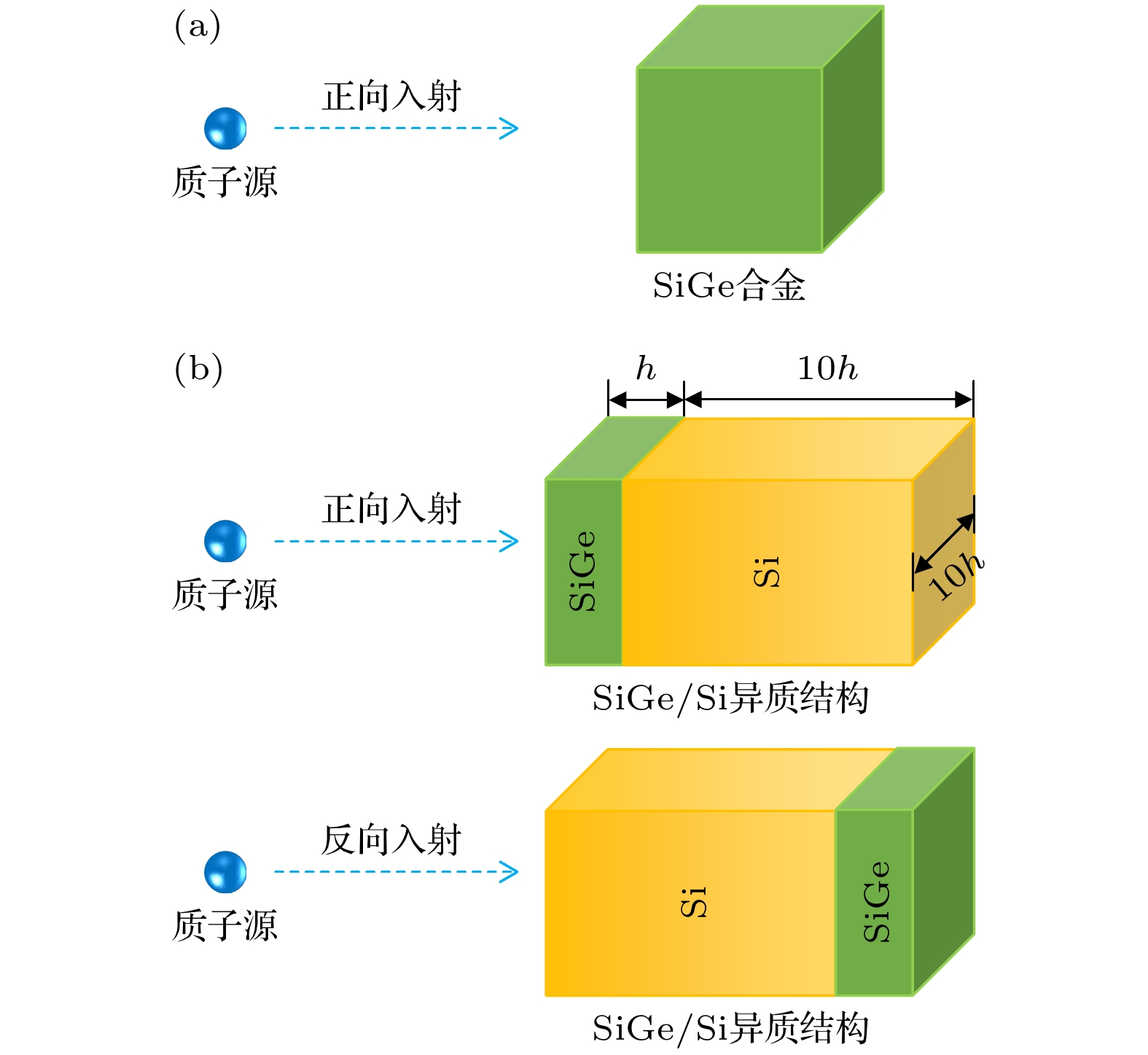
 下载:
下载:
